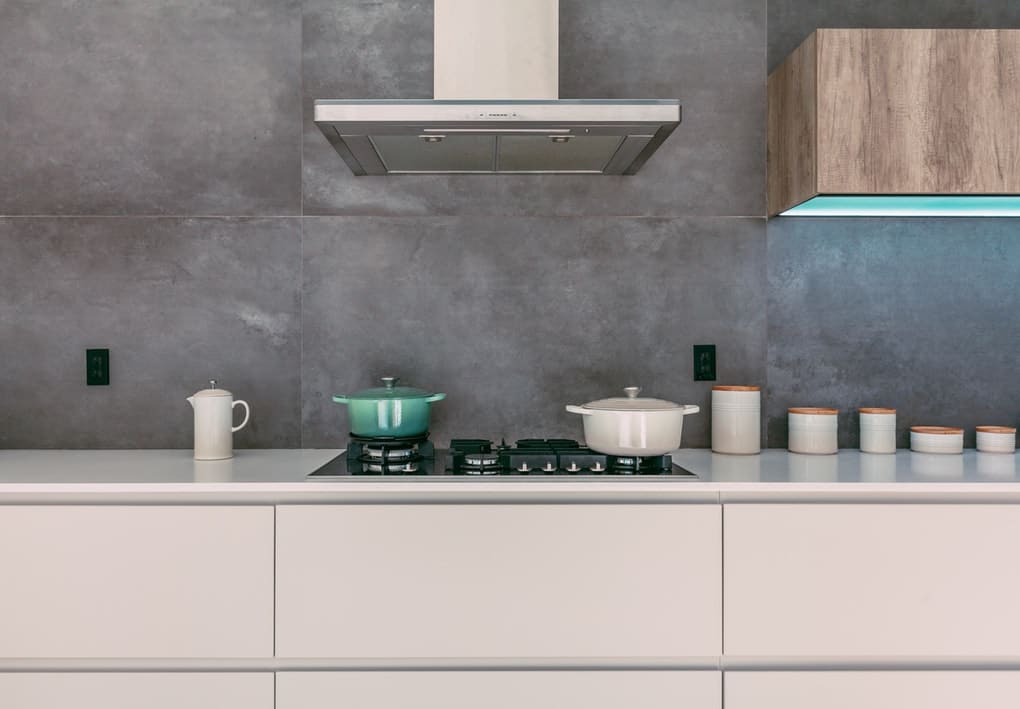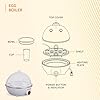
To completely understand how chimney works in kitchen, you need to know the benefits of having this device in your home. Let us have a look at the benefits of a chimney.
1. Removes extra heat from the kitchen
Whenever you are cooking in a closed space, where there is little or no ventilation, the heat from the gas makes the entire kitchen warm. The resultant temperature is far more than the standard room temperature, making your time in the kitchen more taxing. But, if you have a chimney, the overall heat temperatures will be much lower in comparison.
2. Keeps the kitchen walls and ceiling clean
Cooking means using oil, butter, and other sorts of greasy elements. When you heat these items, the vapors that rise from your cooking pots usually are laden with oil and grease molecules. With no escape route, the vapors rise above, cool down, and form greasy layers on the walls and ceiling. Once you install a kitchen chimney, you will see that the device will help prevent accumulation of grease on kitchen surfaces.
3. Removes smoke and soot from the kitchen air
After understanding how kitchen chimney works, you can easily guess that one of the main benefits of this device is that it removes smoke and soot. This is a big benefit if you have an open kitchen.
4. Makes the kitchen look beautiful
Kitchen chimneys help elevate your kitchen’s beauty and elegance.
Related Reading:
Know more about kitchen chimney filters option available in the market.
What Are The Types Of Kitchen Chimney?
Since now you understand how a kitchen chimney works, it’s time to move on and understand the various types of chimneys that are present in the market. Kitchen chimneys can be ducted or ductless.
Chimneys can also be classified based on the way/place of their installation. Also, the device’s installation is highly dependent on the position of your gas since the hood of the chimney must rest directly above the burners. So, here are the following types of kitchen chimney based on their places of installation.
1. Wall-mounted chimneys
If you have your gas burner and the kitchen counter attached to the centrepiece of the wall, you need to choose a wall-mounted chimney. Here, the duct and the exhaust hood are fixed with the wall, such that the chimney covers your entire gas.
2. Island chimney
This style is perfect for kitchens where the gas burner is located on the kitchen island rather than on a wall counter. The chimney is hung from the above, and it rests right above your island top.
3. Corner chimneys
From the name, you can understand that in this system, the kitchen chimney parts are attached to the corner if you have your gas stove located at the corner of the U-shaped or L-shaped kitchen style.
4. Built-in chimneys
These chimneys are fitted inside any kitchen furniture which is mounted on the wall. The air duct is hidden inside the furniture, and the exhaust hood protrudes out from below the furniture’s bottom.
Factors To Keep In Mind Before Purchasing A Chimney

Before ending today’s discussion, we need to focus on one last topic, and that is a brief buying guide for chimneys. So, let’s see what you need to consider when buying a chimney for your kitchen.
1. Chimney type
The first thing you will have to consider is the type of electrical chimney you want for your home. As we have discussed earlier, there are four major chimney types based on the location of your gas stove. However, besides those four, you will also have an option to choose between the ducted and the ductless chimneys.
Noise is one of the important factor to keep in mind while buying kitchen chimney. You can find noiseless kitchen chimney.
2. Chimney filter type
The second thing you need to take care of is the filter type of the chimney. This choice of the filter usually is considered for the primary filter only. Some viable options are – cassette filters, carbon filters, and the baffle filters.
3. Size of the hood
The chimney hood is the umbrella-like structure covering your gas stove completely. Now, since there are different gas sizes with two, three or even four burners, the size of the hood also differs.
4. Price of the chimney
Next thing you will have to consider is the price of the chimney. The price varies according to the chimney brand, the size, the different technologies used in the device, and so on.
5. Features
Look for features like fan power level and chimney auto clean.
Selecting the best kitchen chimney online or offline with the best price available in your budget is hard but not impossible. This chimney buying guide will certainly help you in making the right choice.
Frequently Asked Questions
As you now know, how a chimney works. Here we will answer some of the frequently asked questions by our reader about kitchen chimneys.
1. Does the kitchen chimney require electricity?
The electric kitchen chimney consumes electricity. The power consumption of the chimney depends on how advanced the technology is and what built-in features are equipped within it. Additionally, it depends on how long you use it for.
The average consumption of kitchen chimneys is around 100 to 150 Watts. Besides it, if your chimney has an auto-clean feature, then power consumption for the same would be about 120 to 200 Watts.
2. Does the kitchen chimney reduce heat?
The kitchen chimneys are designed to suck all the strong aromas from the kitchen to keep the kitchen environment odor-free. Besides this, the other benefit of a chimney is that it blows in all the heat produced during cooking, leaving the kitchen cool and free from unwanted odors. Furthermore, it helps in keeping the kitchen free of stains by absorbing grease particles.
3. What does auto clean do in chimneys?
Auto clean is one of the prime focus users keep in mind while buying a chimney. This feature is important because the chimneys with auto clean features need less maintenance compared to the chimneys with manual cleaning.
To clean an auto-clean chimney, you just need to press the button to start the cleaning process. The chimney itself is designed to clean the stains and dirt that collects in a separate collector tray, which can be removed and cleaned.
4. How much suction does a chimney need?
The average suction capacity range should be between 400 m3/hr to 1000 m3/hr. The suction capacity is usually decided based on kitchen size and the heat produced. Ideally, the capacity of the suction should be higher for Indian kitchens which use a lot of intense spices or where the heat production during cooking is high, such as deep frying.
Conclusion
Having a kitchen chimney in your home is a matter of no negotiation or compromise. This device has undoubtedly proven itself to be a friend in disguise, no matter how many bucks you have to spend to bring this appliance in your home. After understanding how chimney works in kitchen, you can confidently bring home a kitchen appliance with many benefits.
































